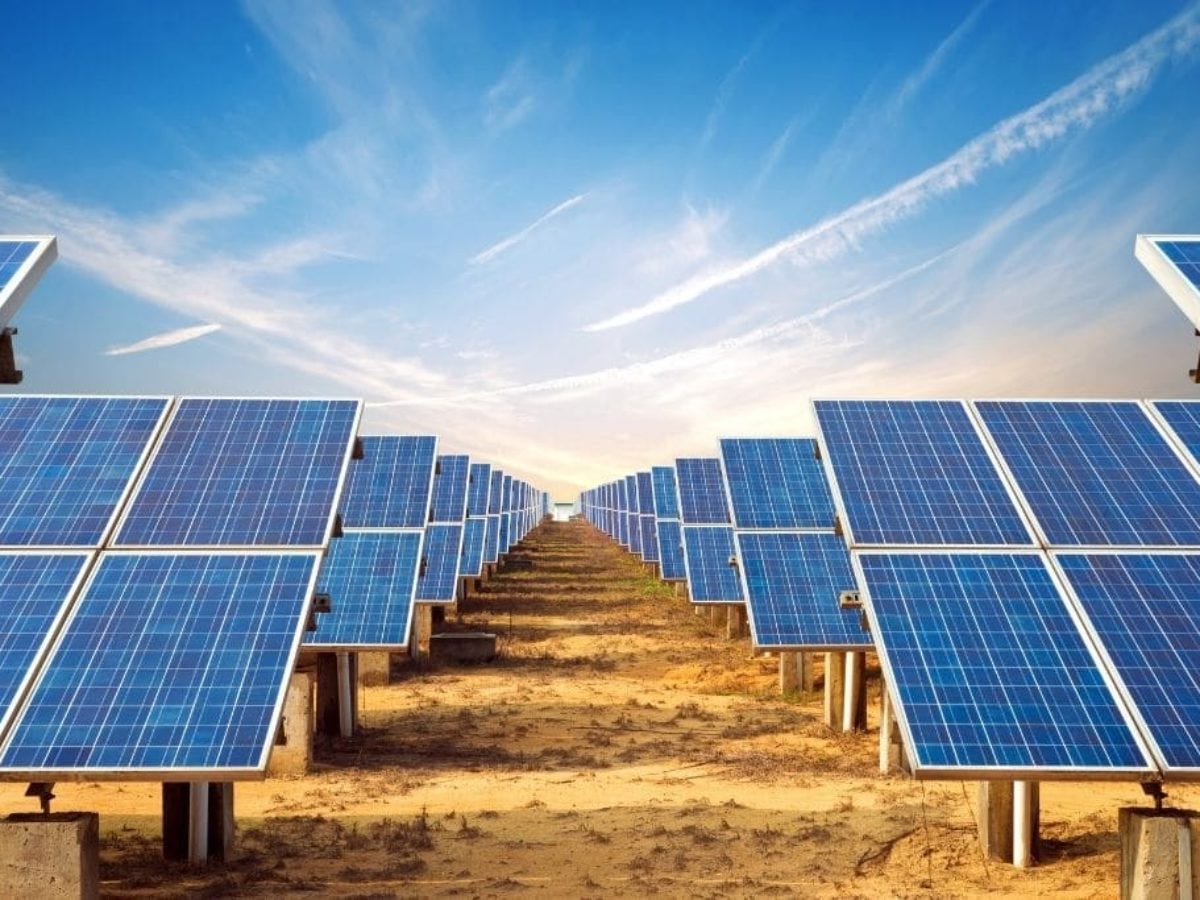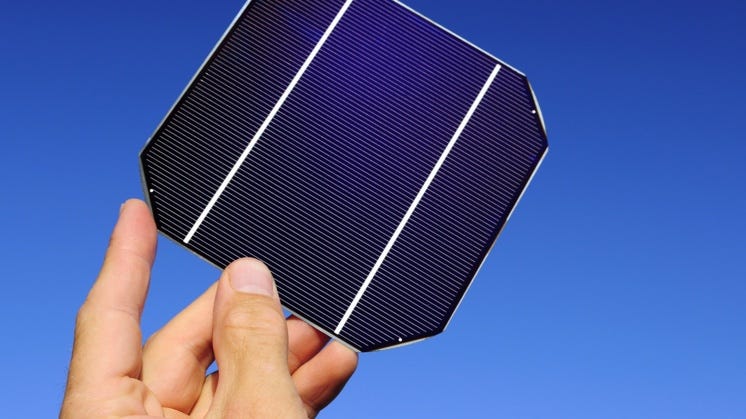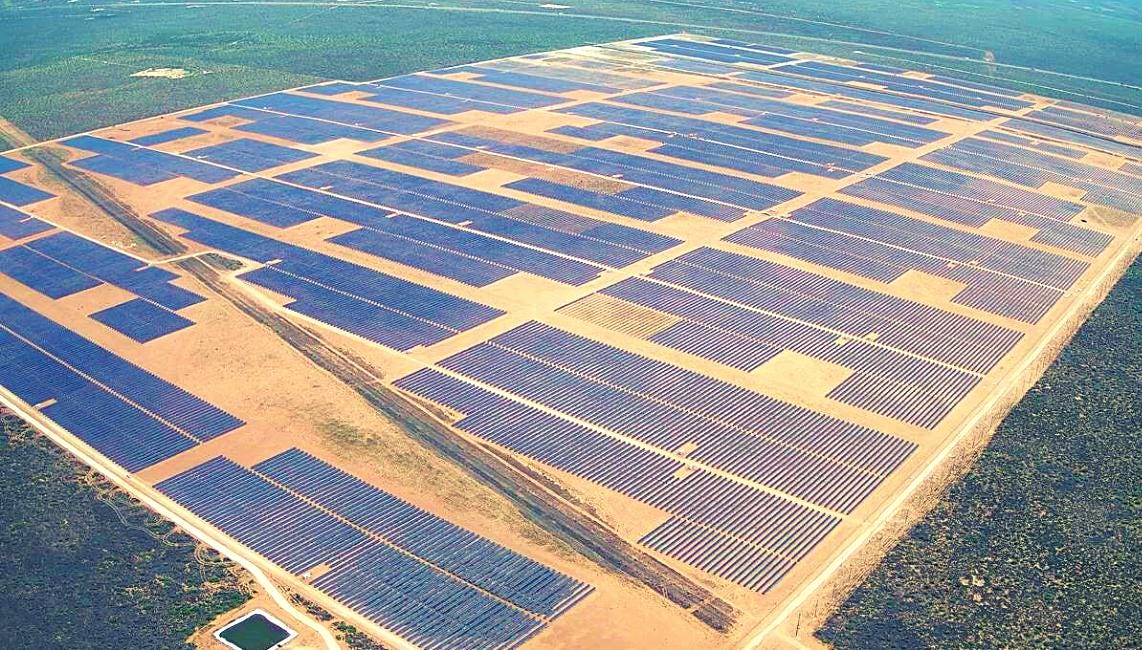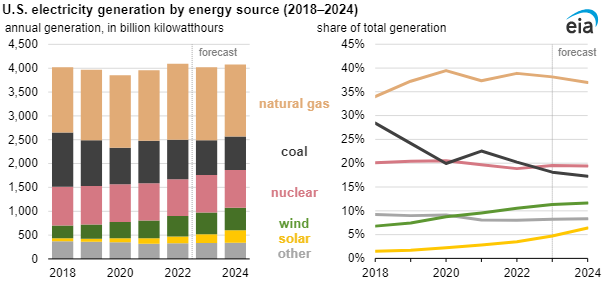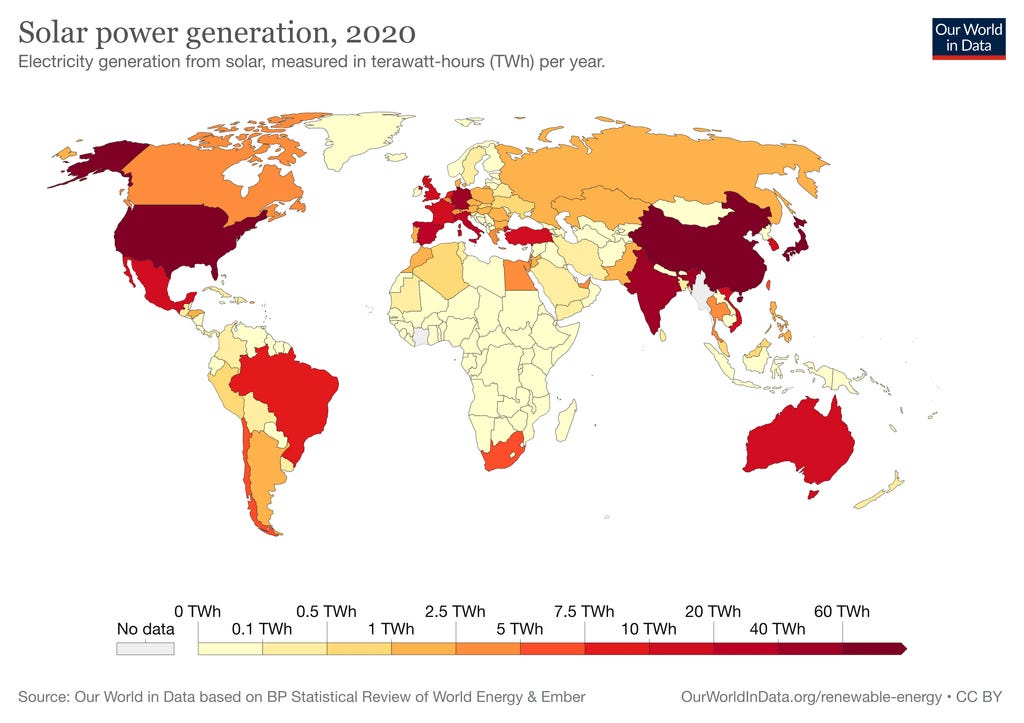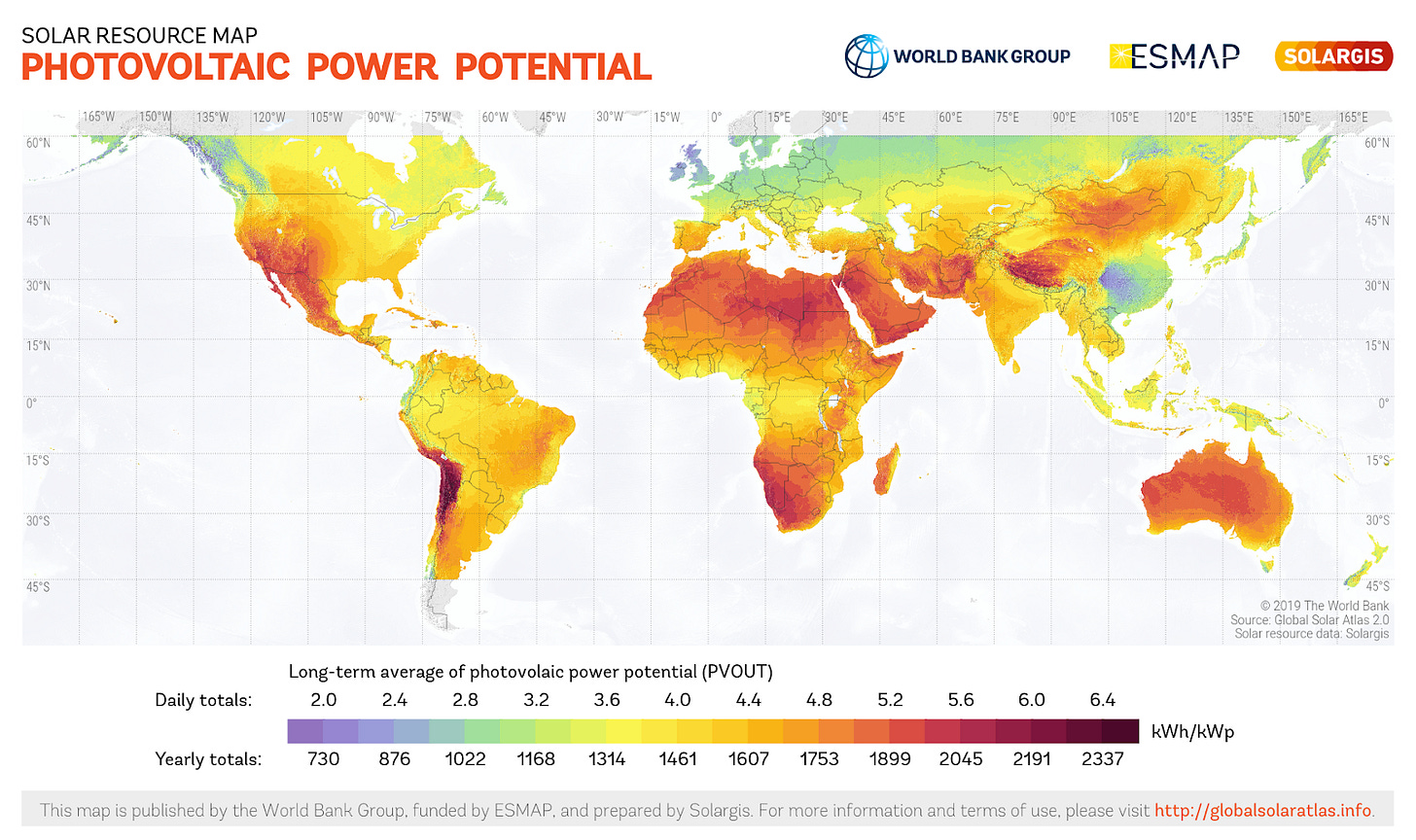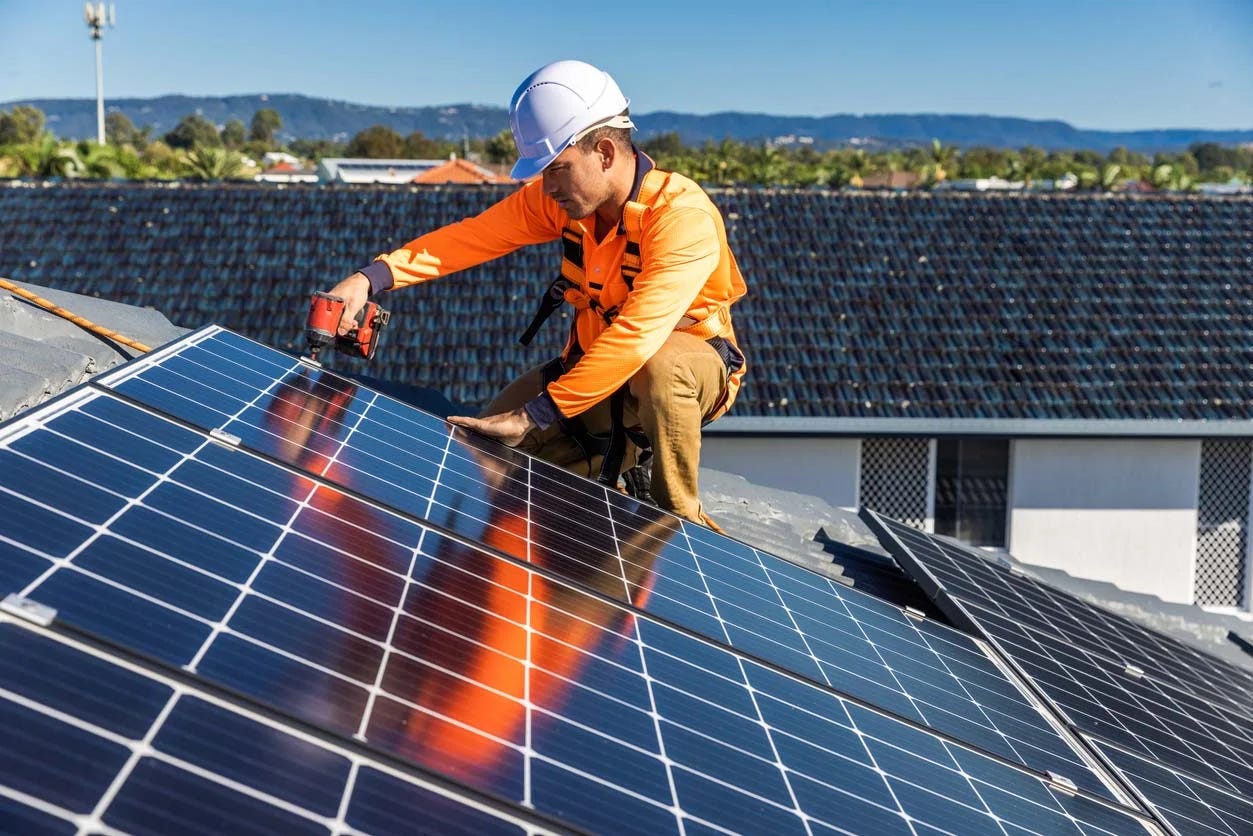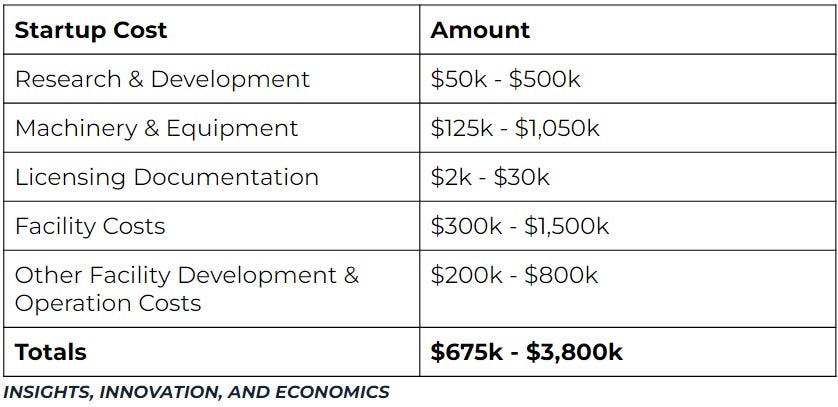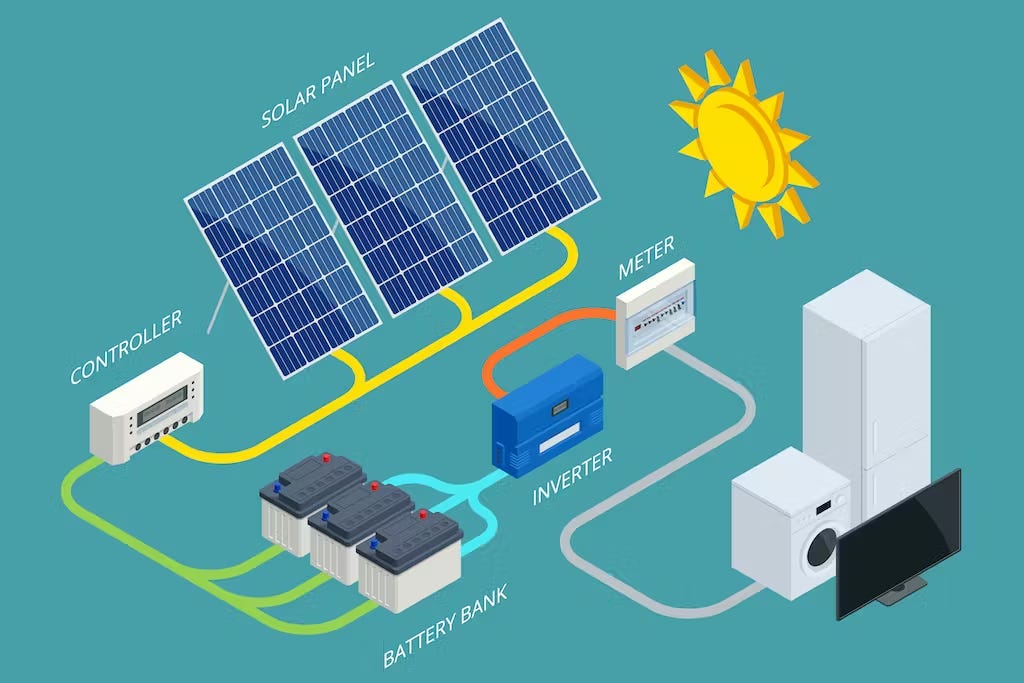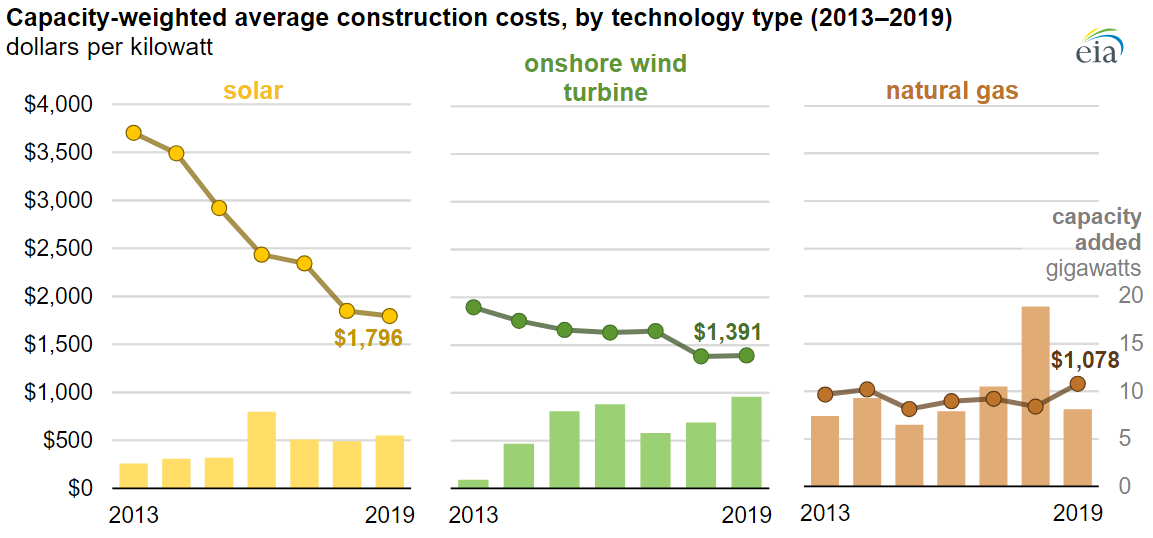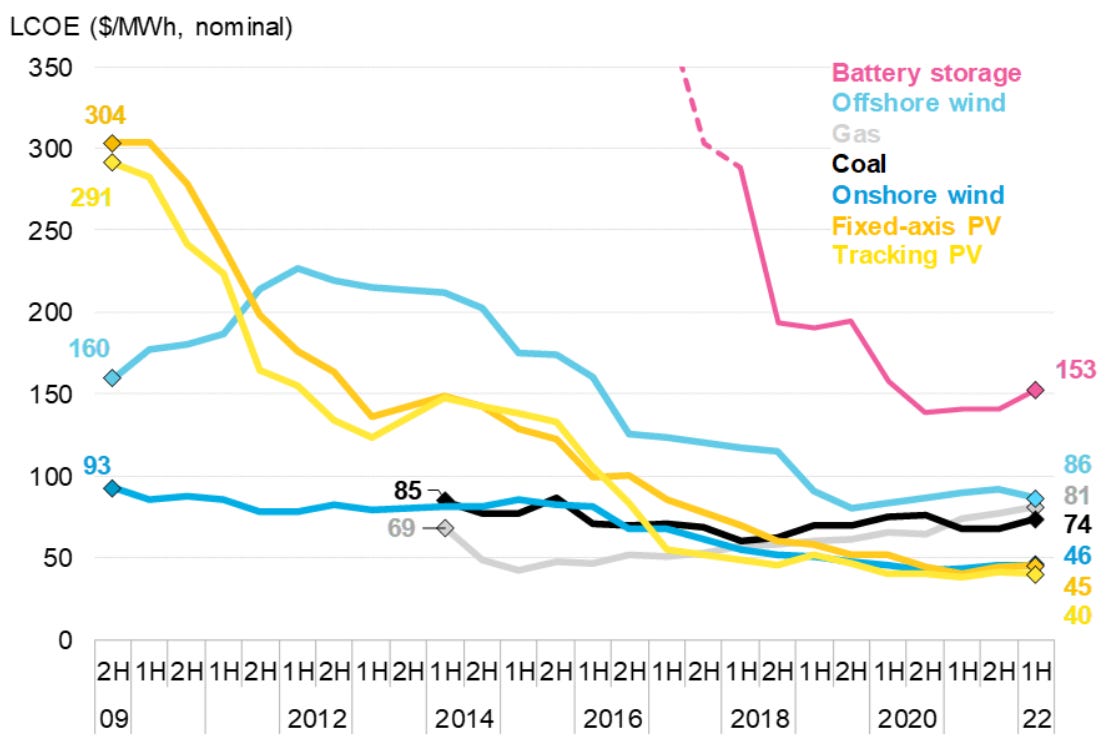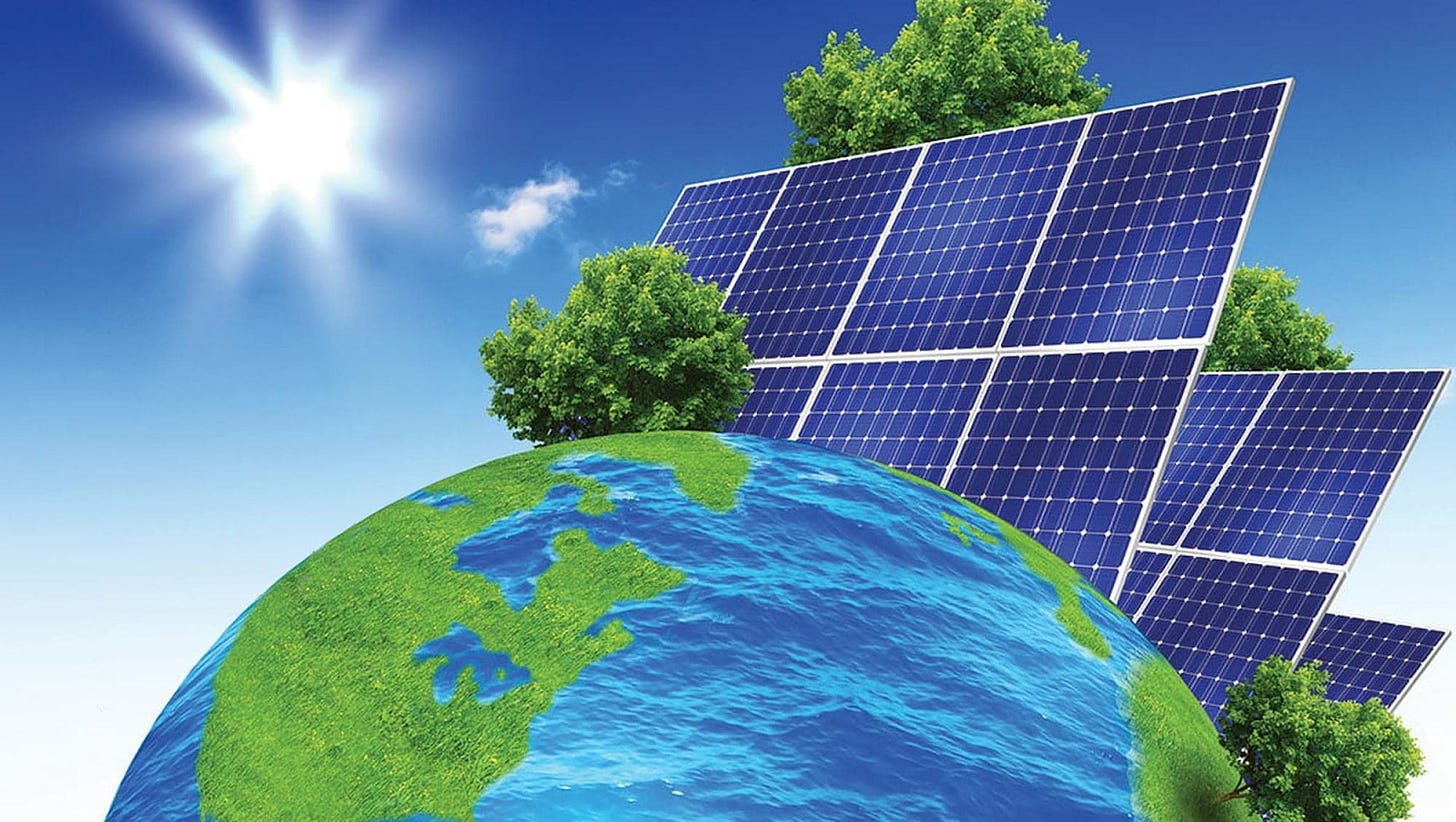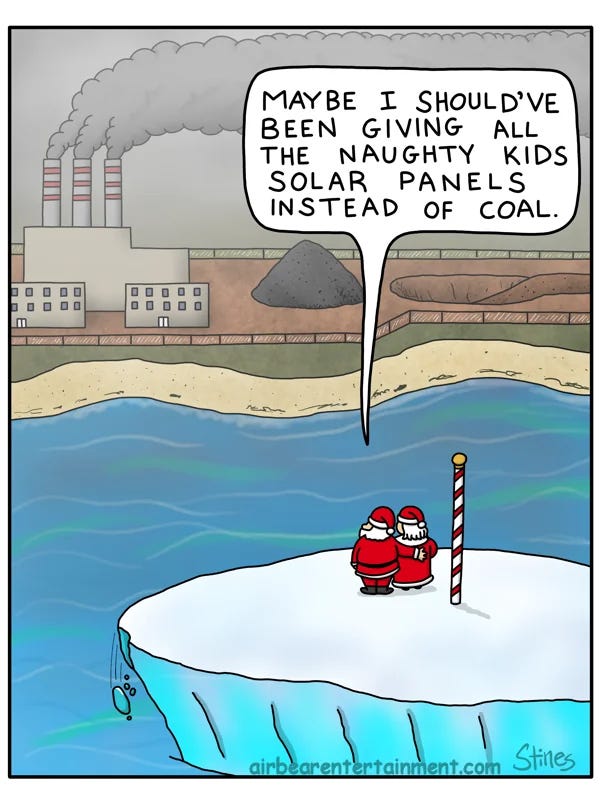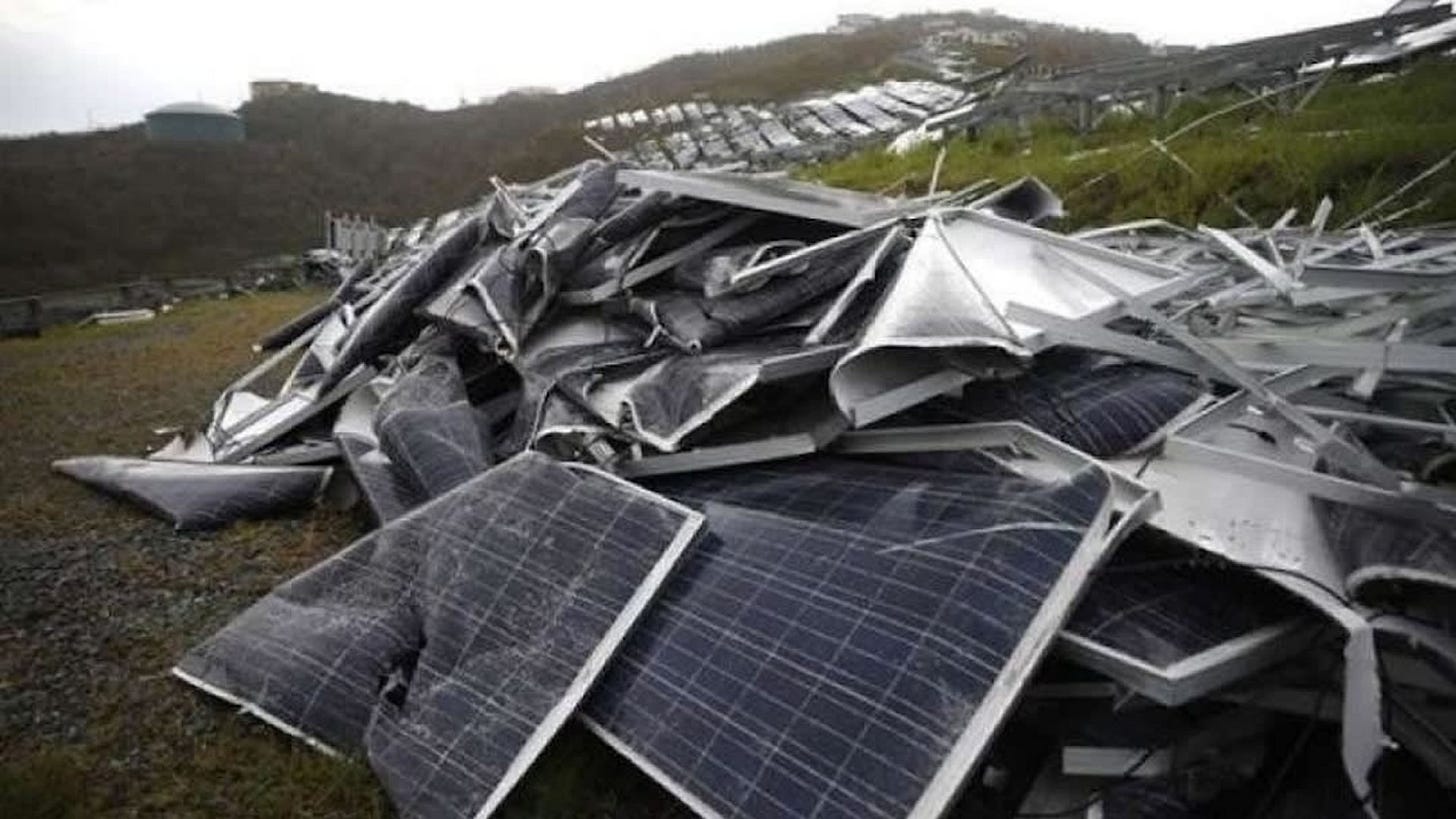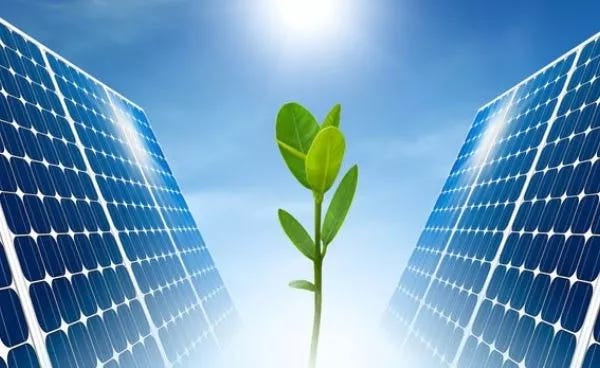Hello!
Welcome to the Insights, Innovation, and Economics blog. If you’re new here, feel free to read my general Introduction to the Blog to understand more about the blog. If you’re returning, thank you, and hope you have a great read!
Thesis: Through innovation, solar energy continues to become more and more cost-effective, so much so that it’s becoming very comparable with fossil fuels, all without the climate downsides. Countries are continuing to transition away from fossil fuels to solar energy. Why? Are they justified?
Credit Earth.org
Solar
If you’ve seen any sort of news over the last couple of years, hopefully you’re familiar with the term solar, but if you’re anything like me you don’t really know much more than the fact that it comes in “panels” and gets energy from the sun.
So, I’m using this space to learn more myself and to hopefully provide a good explanation regarding some of the background, economics, and feasibility of solar energy.
Let’s start with the basics.
What is solar energy?
Solar technologies convert sunlight into electrical energy either through photovoltaic panels or through mirrors that concentrate solar radiation. The energy produced can be used for a variety of different purposes, including generating electricity, put into battery storage, or used as thermal storage.
Diving into the technology a little further, when the sun shines onto a solar panel equipped with photovoltaic panels, energy from the sunlight is absorbed by the photovoltaic cells in the panel. This energy creates electrical charges that move in response to an internal electrical field in the photovoltaic cells, causing electricity to flow. It’s used primarily in smaller-scale operations.
The mirror technology (called concentrating solar-thermal power systems) uses mirrors to reflect and concentrate sunlight onto receivers that collect solar energy and convert it to heat, which then powers steam generators, producing electricity. It’s used primarily in large-scale power plants.
Credit Iberdrola
How long has solar been around?
Solar energy has been used by humans for thousands of years, starting when humans used sunlight to light fires by reflecting the sun’s rays on shiny objects. Ancient Romans and Greeks used solar power with mirrors to light torches for religious ceremonies.
Fast forward to the 1800s when French physicist Edmond Becquerel discovered the photovoltaic effect (he noted that the cell produced more electricity when it was exposed to light).
Fast forward a little more to 1954 when Daryl Chapin, Calvin Fuller, and Gerald Pearson developed the silicon photovoltaic cell at Bell Labs (the first solar cell capable of absorbing and converting enough of the sun’s energy into power to run everyday electrical equipment).
Credit Chariot Energy
Solar Use Cases
The Solar Energy Industries Association cites that there are over 162.8 gigawatts of solar energy installed in the United States. To provide some context, this provides enough energy for around 30 million homes (around 20% of all United States homes).
Credit United States Energy Information Association
Solar currently makes up close to 6-8% of all energy generated in the United States and has been growing in share rapidly.
Reuters cites that added solar capacity in the United States grew 55% in 2023 in comparison to 2022. That doesn’t mean that we added 55% more solar last year, just that the amount of solar added was 55% greater than we added in 2022.
However, solar did account for roughly 50% of all new electricity-generating power sources in 2023, which is a great fact.
So where is solar being used?
Solar energy has a variety of different uses. The most popular include residential, commercial, utility-scale solar farms, and off-grid uses.
Residential solar panels are installed on homes to generate electricity and offset grid power usage. Excess solar power produced can be fed back into the grid.
Commercial solar panels are installed for warehouses, office buildings, retail stores, etc. to power daily business operations and reduce commercial utility bills. In this case, solar power can be used in rooftop or ground-mounted equipment.
Utility-scale solar farms are large-scale ground-mounted solar installations spanning acres of land that feed solar power directly into the grid.
Off-grid systems employ solar power and battery technology to provide 100% of a home’s power needs. This is often used in rural or remote areas lacking connections to the traditional power grid.
The variety of uses for solar technology has vastly increased the amount of solar energy used in the world as showcased by the graphic below.
Credit Earth.org
The main countries promoting solar growth are China and the United States, which makes sense because these two countries consume large amounts of energy (traditionally fossil fuels).
To provide more context for solar potential, scientists have created graphics like the one below that show the photovoltaic power potential of regions throughout the world.
Credit SolarReviews
Essentially this shows where solar could be effectively employed in the world (correlated to where there are large amounts of sunlight). This is great to show the potential that solar has in the world, but it doesn’t show directly why solar is being used over other sources of energy
Solar Economics
At the core, the decision to use one source of energy or another depends on the costs.
With solar energy, costs come from a couple of different places. First, there are costs associated with building and developing the solar panels and the technology. Second, there are the costs associated with transport and installation. Third, there are the costs associated with the distribution and storage of solar energy.
Credit Bob Vila
Startup Costs
Analysis from Finmodelslab cites the following cost structure for a solar panel startup.
Research and development costs anywhere from $50k - $500k for the development of feasible solar panel technology. It’s crucial for the development of efficient, effective solar panels as well as continuous improvement in energy efficiency.
The cost of the equipment needed to start a solar panel business is anywhere from $25k - $750k depending on the specifics of the operations. In addition, costs for a solar laboratory to test solar cells can cost anywhere from $50k - $200k. And finally, machining tools cost approximately $50k - $100k depending on the desired quality, grade, and specifications.
In addition, solar panel startups need to have the proper documentation and licensing associated with running this type of operation, ranging anywhere from $2k - $30k.
Facility costs generally range from $300k - $1,500k, including the costs for molds, dyes, punches, capital equipment, raw materials, and other necessary items for the manufacturing process.
All of the above doesn’t even include other development/operational costs including wages, materials, utilities, insurance, maintenance, marketing, etc. which can amount to $200k - $800k.
Input Costs
Solar panels are made up of several different types of materials, many of which need to be purchased from a variety of different vendors including photovoltaic cells, solar cells, glass, EVA and back sheets, aluminum frames, special wires, junction boxes, surface texturing agents, etc.
Currently, the average cost for crystalline solar panels and their cells can range from $0.25 - $5. Solar panels traditionally contain anywhere from 32-96 cells for a total of $8 - $480 per solar panel.
A MONO-PERC solar panel may require estimated raw material costs of $0.1 to $0.12 per watt, amounting to an estimated $100-$120 for each panel.
Forbes estimates that the average materials costs are around $0.90 - $1.5 per watt.
Installation Costs
There is a general lack of clear information regarding the amount it costs to install or transport solar panels either for residential or utility-scale solar farms.
Claude, an artificial intelligence program developed by Anthropic, estimates the typical rooftop solar system installation costs for a single home usually range from $3k - $5k.
For utility-scale solar farms, installation costs are generally around $0.1 - $0.25 per watt, and transport costs can add around $0.05 - $0.15 per watt, for a total of an additional $0.15 - $0.4 per watt in costs.
Credit Unbound Solar
Distribution and Storage
Distribution and storage costs are where solar gets complicated. As solar is dependent mainly on sunlight, it can produce quality energy during the day (conveniently also when energy demand is usually higher). Yet, there’s a problem during the night, as solar energy cannot produce energy.
So, this is where storage technology (typically a battery) is used to facilitate the capture of excess energy during the day to power operations during the night.
So, how expensive are these batteries?
For residential systems, Claude estimates a lithium-ion battery to provide a backup capacity of 4-8 hours of overnight power usage costing around $8k - $16k. For utility-scale solar farms, the cost generally is around $0.1 - $0.25 per watt.
But, battery technology is continually improving as it’s a major facilitator of solar energy and will be integral to our renewable energy transition into the future.
Total Solar Costs
So, to summarize the above, the startup costs for a solar panel startup range from $675k to multiple millions.
Then for material inputs, transportation, battery storage, etc.--all of the variable costs associated with solar panels themselves, the costs are the following:
For a 5 KW residential solar panel system, the costs range from $15k - $28k.
For a 100 MW utility-scale solar farm, the costs range from $115M to $215M.
Solar Costs in Comparison
Costs are only important when compared to other sources of energy.
Credit United States Energy Information Administration
Through innovation, solar energy is becoming more cost-comparable with other sources of energy.
This can be seen especially through the LCOE calculations from Bloomberg:
Credit Bloomberg
Arguably solar energy is the cheapest source of energy currently.
What more needs to be said?
Actually a lot more.
Let’s talk about the positives of solar energy.
Credit LA Solar Group
Pros of Solar
Pro #1: Solar energy is a renewable energy source that doesn’t produce C02
Solar energy, as it is based on the sun, is truly renewable. The sun isn’t running out for millions of years, so, in actuality, solar energy could last us forever. It’s probably one of the best sources of energy we have currently (or even that we could have in the future).
Solar energy doesn’t produce carbon emissions in the process of producing energy (in contrast to fossil fuels).
The only carbon emissions produced by solar are through the development and manufacturing of the solar panels themselves (which still isn’t great but definitely better than current options). However, the United States Office of Energy Efficiency & Renewable Energy issued a report explaining that solar panels pay for themselves in terms of greenhouse gas emissions within one to four years of use.
Pro #2: Solar energy is geared toward everyday consumers
Solar power is an understandable, usable energy source that can be geared towards the everyday consumer. Unlike a wind turbine or nuclear power plant, you can have solar panels within your dwelling.
This allows an angle of energy production and consumption and honestly a caring about energy that we haven’t seen before. People are installing solar panels on their homes for the sole purpose of reducing their electricity bills. This access to renewable energy and energy security at an individual level is unprecedented.
Instead of having to rely on the electric power plant located in your city, you can supply your own power and own power storage, and in some cases, be able to do this off-grid.
That’s crazy.
I’m not sure if you’re able to comprehend how crazy that is, but this capability is going to massively change how we think about and approach energy in the future.
Pro #3: Solar panels are easy to maintain
Solar panels don’t often require ongoing maintenance, and when cared for properly, can last upwards of 25 years simply on the technology we have today. I bet in the coming years, we will continue to innovate and extend this timeline even further.
Pro #4: Solar panels can generate electricity in any climate
Solar panels are subject to temporary weather disruption. Cloudy days reduce the amount of electricity produced. Cold, however, doesn’t affect solar energy production. How much of a benefit is this? Well, it’s not a detriment (which is good), but other sources of energy, like fossil fuels, nuclear, or even wind can be produced in many climates.
Pro #5: Solar energy provides increased energy security
By using the sun as the primary energy source, employing vast amounts of solar energy can allow a country to reduce its dependence on outside entities for energy production.
Consider an example where your country relies majorly on fossil fuels for energy production and consumption. In a scenario where the major oil-producing and exporting countries (OPEC) choose to vastly limit their production and exportation of oil, in turn skyrocketing the price of oil, your country is in a bad situation.
On one hand, you need the energy to survive, but at what cost? Because you haven’t developed the capabilities to mass-switch or use another technology to produce your energy, you’re stuck paying exorbitant prices.
So, solar energy, in this scenario and many like it, provides critical energy security capabilities to countries that previously wouldn’t have had it.
Pro #6: Continuous innovation leading to increased capabilities and decreased costs
As solar energy continues to be a worldwide project, innovations within the field happen almost daily. This means that the capabilities of solar energy and the potential uses of the technology keep getting more and more attractive. And that’s even before cost efficiencies from mass production.
Unlike a nuclear power plant or other large-scale power plant, as solar panels are relatively small, they can easily be manufactured in a factory, providing possibilities for economies of scale.
Through mass production and mass consumption, the demand for solar panels creates value for innovation within the field and the supply of solar panels creates value for economies of scale within the field, a double benefit.
Pro #7: Solar provides a solution to rising energy prices
The world can only produce so much energy. However, the demand for energy is growing faster than the supply of energy, especially considering the exponential adoption of energy-consuming technologies.
Solar energy provides a relatively easy way to increase energy supply, concentrated at the individual level (as discussed above). This low-cost energy technology is being adopted by consumers for the simple reason it provides a hedge against rising energy prices in the future due to high demand.
Credit Reddit
Cons of Solar
Con #1: High Cost of Startup
As explained above, the cost of solar energy production and startup is extremely high (yet in comparison to other energy sources like nuclear, it is lower).
Con #2: Solar energy storage is expensive
Current battery technology is still expensive relative to the amount of energy capable of being stored. Granted, innovations are happening in this field right and left, but it hasn’t come far enough yet.
Con #3: Solar energy depends on sunlight
Unlike a power source like nuclear or fossil fuels, solar panels can’t generate electricity 24/7. They depend on sunlight. Unfortunately, this limits their ability to be used and relied on 24/7 for large-scale energy grids.
Con #4: Solar needs large amounts of space to operate
Unlike the small solar panels powering your calculator or portable battery, most industrial or residential-sized solar panels aren’t small. They need to be put somewhere in order to generate energy. And as land continues to be used up, finding places for solar is becoming more and more difficult.
For example, for a solar power plant to provide electricity for 1,000 homes, you would need 32 acres of land. Extrapolated further, to meet all of the United States' energy needs, nearly 19 million acres, equivalent to 0.8% of the entire country, would be necessary.
Luckily we’ve found solutions for this in the fact that we’ve started putting solar panels on roofs, previously unused space. This has worked great for residential and commercial use, but for utility-scale solar farms, the space required simply isn’t enough, so we see large, previously unused countryside being used for solar power.
Is that good? It depends on who you ask. It’s given us a use for “non-ideally placed land”, but in using solar for this, we lose the natural value of nature.
Credit Interesting Engineering
Con #5: Solar recycling and disposal
The Harvard Business Review has a very interesting article discussing the current state of solar recycling and disposal that I’ll summarize below:
Most estimates of solar waste don’t take into account the fact that upgrading solar panels is becoming an increasingly attractive proposition (as costs have decreased 50-90% and efficiency has increased 10-50%). So, many people may actually make money by replacing their solar panels before their lifespan is fully finished.
The solar industry is woefully unprepared for the amount of waste that is likely to come from consumers retiring solar at or before the end of the panel’s lifetime. The incentive to recycle has never been large in solar as these panels do contain small amounts of valuable materials, but are mostly made of glass (an extremely low-value material).
As a result, solar’s exponential product boom has left recycling infrastructure to waste. With current capacity, it costs an estimated $20-$30 to recycle one solar panel. However, sending that same solar panel to a landfill would just cost around $1-$2. The economics don’t make sense to recycle.
To quote the article directly:
The direct cost of recycling is only part of the end-of-life burden, however. Panels are delicate, bulky pieces of equipment usually installed on rooftops in the residential context. Specialized labor is required to detach and remove them, lest they shatter to smithereens before they make it onto the truck. In addition, some governments may classify solar panels as hazardous waste, due to the small amounts of heavy metals (cadmium, lead, etc.) they contain. This classification carries with it a string of expensive restrictions — hazardous waste can only be transported at designated times and via select routes, etc.
Considering the economics associated with waste and recycling, solar panels look worse and worse. The Harvard article cites that including these costs would catapult the LCOE of solar to 4x the current projections.
The economics of solar — so bright-seeming from the vantage point of 2021 — would darken quickly as the industry sinks under the weight of its own trash.
Con #6: Solar relocation isn’t very economical
At least at this point, solar panels aren’t very movable. Uninstalling a solar system, moving it, then reinstalling it is time-consuming and expensive. Granted, this fact may change in the future as solar panels may be able to be moved.
But for now, solar panels can be seen more as an investment in the structure or property they’re added to.
Credit Sunsolar Solutions
Solar is a Great Energy Source
Solar has proven to be a great renewable source of energy. Countries have invested in and continue to plan future investments in the development and deployment of solar energy. It provides a good resource for a variety of reasons, summarized below:
Mitigating climate change: To accomplish climate pledges, solar energy has been utilized as a non-carbon-producing energy source in many countries and looks to continue to be utilized as climate goals become more stringent.
Improve energy security: Locally generated solar electricity reduces dependence on imported fossil fuels and other sources of energy vulnerable to price and supply instability. Solar provides energy autonomy and reliability.
Economic growth: Solar investment creates many new jobs in manufacturing, construction, maintenance, transportation, and other sectors.
Health benefits: Expanding solar energy production curtails fossil fuel emissions and improves public health outcomes.
Rapid scalability: Solar can be deployed much more rapidly across distributed sites than conventional centralized power plans, able to match a country’s needs.
This combination of environmental, economic, and technical innovation is driving more countries to embrace solar energy as a major pillar of their national renewable energy plans and commitments.
Is solar the best solution?
Currently, solar is a top solution, and through continued innovation and improvement in economics, solar may become the standout energy solution.
Anywho, that’s all for today.
-Drew Jackson
Disclaimer:
The views expressed in this blog are my own and do not represent the views of any companies I currently work for or have previously worked for. This blog does not contain financial advice - it is for informational and educational purposes only. Investing contains risks and readers should conduct their own due diligence and/or consult a financial advisor before making any investment decisions. This blog has not been sponsored or endorsed by any companies mentioned.
Bonus: What I’m Listening to Today:



